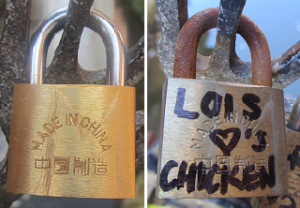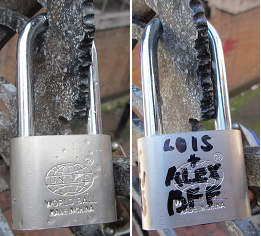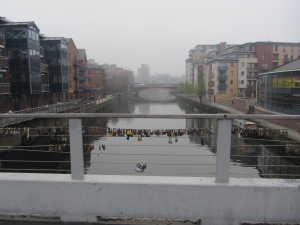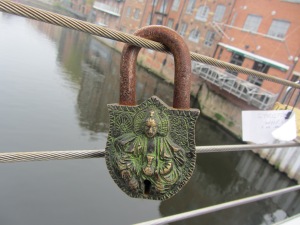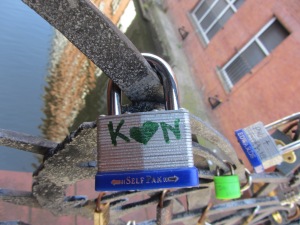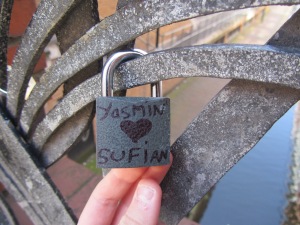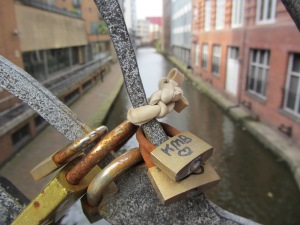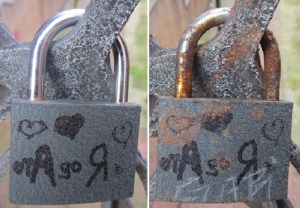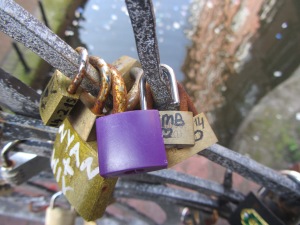Two more love-locks have been “hijacked” over the weekend, one originally deposited in February and the other in August of last year.
Monthly Archives: April 2015
Love-Locks in Otley
Love-Locks in Leeds
I was at a workshop today at the University of Leeds and obviously couldn’t resist going in search of love-locks. I knew there were some on the Centenary Bridge but didn’t realise how many – it’s quite a well-established accumulation, with most love-locks dated to 2014 and 2015, and there were some really interesting deposits.
Some love-locks were clustered together in “family-groups”.
Some love-locks were very elaborately decorated using paints and what I assume to be nail varnish.
Some love-locks were already decorated as part of their initial design. One with love-hearts and the word “love” written all over its surface in pink letters. One with a boy on one side, a girl on the other, and a love-heart between them, with the words “love is” written inside. And another was an incredibly opulent padlock, with what I think is religious imagery (Buddhism?) – I’ve never seen anything like it before and have no idea where the depositor could have sourced it.
Some love-locks aren’t love-locks at all: there’s a piece of torn paper with the words “Stretch why did you do it” safety-pinned to the railing and, bizarrely enough, a shoe, hanging by its laces. Having researched the folklore and semiotics of the shoe (as a liminal object with a metonymical association with its wearer and hence the focus of various rituals and popular beliefs) for my MA, it’s tempting to believe the depositor of this shoe invested deep meaning in the choice of their deposit. But, as ever, we must be wary of over-interpretation. What this shoe and piece of safety-pinned paper probably indicate is that some depositors simply don’t come prepared with a padlock to deposit, and so choose to leave something else instead.
However, what’s unusual about the shoe is that – whilst other ad-hoc deposits tend to be both handy and dispensable (e.g. paper, hair bobbles, elastic bands) – you wouldn’t really class footwear as such. Handy, yes, but not really dispensable. Did the depositor hop home?
20/04/2015 – Fellow Love-Lock Hunters
At the weekend I attended the Folklore Society’s AGM in Sheffield (brilliant conference), where I got talking to fellow folklore researchers about love-locks. I was directed to the February 2015 FLS Newsletter in which Fionnuala Carson Williams, Linda Ross, and Doc Rowe have shared their knowledge of the custom. They list the following as love-lock locations: Vilnius, Krakow, Faro, Belfast, Dublin, Cork, Newcastle, and Lothian. Williams and Ross have provided a description of the assemblages in Faro, and their observations mirror my own: most are individual but some appear to have been deliberately grouped; some have been professionally engraved but most are marked with pen/marker; and judging by the names (not Portuguese), many appear to have been deposited by foreign tourists.
It really is remarkable how quickly and widely this custom is spreading, and I like the expression used by Williams and Ross: it has ‘mushroomed’.
Meanwhile, two new love-locks in Manchester take the number up to 87:
13/04/2015 – A Hijacking and an Alternative Deposit
It’s been an exciting day in the world of the Manchester love-lock accumulation (I say the word ‘exciting’ without a hint of irony). Three new deposits have been added: two love-locks and what I imagine to be somebody’s handy alternative: an elastic band, tightly tied around a post. This suggests that ad-hoc deposits are made when deposition on the bridge hasn’t been planned (along with the plastic bags, ribbon, and lighters also attached).
Also, one of the love-locks recorded in November 2014 has been “hijacked” – beneath the original message, somebody’s scratched on the name ‘Gabi’ (see comparative picture – note also the level of corrosion it’s undergone over the last 5 months). Again, has somebody come across the love-lock bridge by chance, wanted to make a deposit, but having nothing suitable to leave, decided to add to somebody else’s? I wonder how the original depositor(s) would feel. Would they see their deposit as personal and be annoyed/offended/angry/hurt that somebody else had added their name, essentially laying claim to the love-lock as well? Or would they take the view that once a love-lock has been deposited, it’s no longer their private property but is part of a public monument and therefore liable to be altered – or even taken?
I’m itching to gather some ethnographic data about this – to talk to the depositors themselves. But the Manchester bridge is too small, with only a few deposits being added per week. What I really need to do is take some time at a more established accumulation (Liverpool maybe) and try to get some interviews. If time and funding ever permit…

